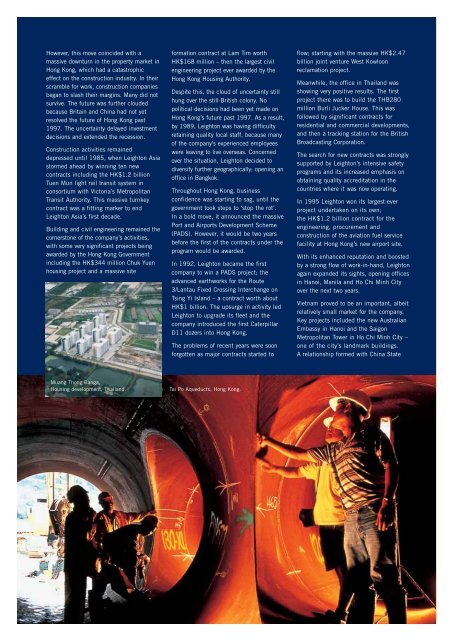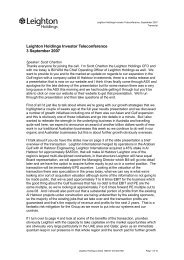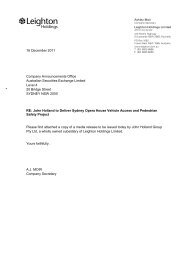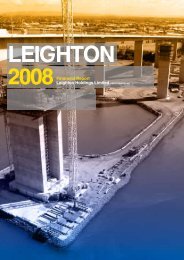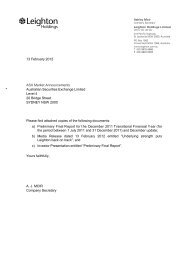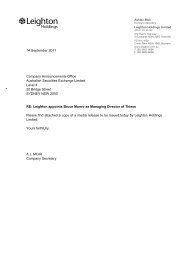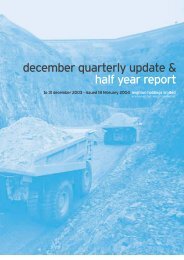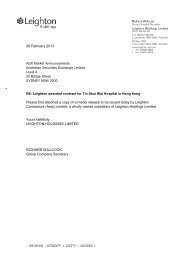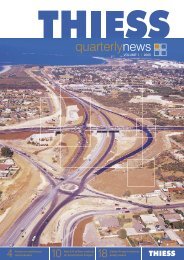Leighton Asia News, July 2005 - Leighton Holdings
Leighton Asia News, July 2005 - Leighton Holdings
Leighton Asia News, July 2005 - Leighton Holdings
Create successful ePaper yourself
Turn your PDF publications into a flip-book with our unique Google optimized e-Paper software.
However, this move coincided with a<br />
massive downturn in the property market in<br />
Hong Kong, which had a catastrophic<br />
effect on the construction industry. In their<br />
scramble for work, construction companies<br />
began to slash their margins. Many did not<br />
survive. The future was further clouded<br />
because Britain and China had not yet<br />
resolved the future of Hong Kong past<br />
1997. The uncertainty delayed investment<br />
decisions and extended the recession.<br />
Construction activities remained<br />
depressed until 1985, when <strong>Leighton</strong> <strong>Asia</strong><br />
stormed ahead by winning ten new<br />
contracts including the HK$1.2 billion<br />
Tuen Mun light rail transit system in<br />
consortium with Victoria’s Metropolitan<br />
Transit Authority. This massive turnkey<br />
contract was a fitting marker to end<br />
<strong>Leighton</strong> <strong>Asia</strong>’s first decade.<br />
Building and civil engineering remained the<br />
cornerstone of the company’s activities,<br />
with some very significant projects being<br />
awarded by the Hong Kong Government<br />
including the HK$344 million Chuk Yuen<br />
housing project and a massive site<br />
formation contract at Lam Tim worth<br />
HK$168 million – then the largest civil<br />
engineering project ever awarded by the<br />
Hong Kong Housing Authority.<br />
Despite this, the cloud of uncertainty still<br />
hung over the still-British colony. No<br />
political decisions had been yet made on<br />
Hong Kong’s future past 1997. As a result,<br />
by 1989, <strong>Leighton</strong> was having difficulty<br />
retaining quality local staff, because many<br />
of the company’s experienced employees<br />
were leaving to live overseas. Concerned<br />
over the situation, <strong>Leighton</strong> decided to<br />
diversify further geographically; opening an<br />
office in Bangkok.<br />
Throughout Hong Kong, business<br />
confidence was starting to sag, until the<br />
government took steps to ‘stop the rot’.<br />
In a bold move, it announced the massive<br />
Port and Airports Development Scheme<br />
(PADS). However, it would be two years<br />
before the first of the contracts under the<br />
program would be awarded.<br />
In 1992, <strong>Leighton</strong> became the first<br />
company to win a PADS project; the<br />
advanced earthworks for the Route<br />
3/Lantau Fixed Crossing Interchange on<br />
Tsing Yi Island – a contract worth about<br />
HK$1 billion. The upsurge in activity led<br />
<strong>Leighton</strong> to upgrade its fleet and the<br />
company introduced the first Caterpillar<br />
D11 dozers into Hong Kong.<br />
The problems of recent years were soon<br />
forgotten as major contracts started to<br />
flow; starting with the massive HK$2.47<br />
billion joint venture West Kowloon<br />
reclamation project.<br />
Meanwhile, the office in Thailand was<br />
showing very positive results. The first<br />
project there was to build the THB280<br />
million Burli Jucker House. This was<br />
followed by significant contracts for<br />
residential and commercial developments,<br />
and then a tracking station for the British<br />
Broadcasting Corporation.<br />
The search for new contracts was strongly<br />
supported by <strong>Leighton</strong>’s intensive safety<br />
programs and its increased emphasis on<br />
obtaining quality accreditation in the<br />
countries where it was now operating.<br />
In 1995 <strong>Leighton</strong> won its largest-ever<br />
project undertaken on its own;<br />
the HK$1.2 billion contract for the<br />
engineering, procurement and<br />
construction of the aviation fuel service<br />
facility at Hong Kong’s new airport site.<br />
With its enhanced reputation and boosted<br />
by a strong flow of work-in-hand, <strong>Leighton</strong><br />
again expanded its sights, opening offices<br />
in Hanoi, Manila and Ho Chi Minh City<br />
over the next two years.<br />
Vietnam proved to be an important, albeit<br />
relatively small market for the company.<br />
Key projects included the new Australian<br />
Embassy in Hanoi and the Saigon<br />
Metropolitan Tower in Ho Chi Minh City –<br />
one of the city’s landmark buildings.<br />
A relationship formed with China State<br />
Muang Thong Banga,<br />
Housing development, Thailand.<br />
Tai Po Aqueducts, Hong Kong.


